Feb 29, 2020 04:00 am
Thank you for visiting or signing up to this blog, I do hope you enjoy reading it, and are as surprised as I am at some of the hidden gems of our glorious history that are to be discovered. Please come and see the 24 pins for February, a month in which Marines were at the extremes of both West and South, has any other unit in the world conducted an operation that far south, unlikely! There have been 86 leap years since the birth of the Royal Marines, and Royal Marines would have been deployed somewhere in the world on the 29th February on almost all of them, so we still have a few to add! Leap years since 1664; 1664, 1668, 1672, 1676, 1680, 1684, 1688, 1692, 1696, 1704, 1708, 1712, 1716, 1720, 1724, 1728, 1732, 1736, 1740, 1744, 1748, 1752, 1756, 1760, 1764, 1768, 1772, 1776, 1780, 1784, 1788, 1792, 1796, 1804, 1808, 1812, 1816, 1820, 1824, 1828, 1832, 1836, 1840, 1844, 1848, 1852, 1856, 1860, 1864, 1868, 1872, 1876, 1880, 1884, 1888, 1892, 1896, 1904, 1908, 1912, 1916, 1920, 1924, 1928, 1932, 1936, 1940, 1944, 1948, 1952, 1956, 1960, 1964, 1968, 1972, 1976, 1980, 1984, 1988, 1992, 1996, 2000, 2004, 2008, 2012, 2016, 2020 
Read in browser »
   
Feb 27, 2020 04:22 am
Boer War memorial. Erected on 27th February 1904; by Harry Hems, inscribed with the words 'Ready-Aye-Ready'.  Erected as a memorial to the crew of HMS Doris who died fighting in South Africa alongside the army at the Battle of Paardeberg. This field gun was captured from the Boers and dragged the distance of 800 hundred miles back to their ship HMS Doris. In 1901 HMS Doris returned to Devonport to an heroic welcome and the crew decided there should be a memorial to the sailors who died in the battle. The memorial was unveiled in 1904 by Admiral E.H. Seymour. It is said that the exploit was the origin of Royal Navy field gun trials.  Image: Royal Marines from HMS Doris in Cape Town. Captain Senior is marching on the right. Senior was killed in the storming of the Boer position by the Naval Brigade at the Battle of Graspan on 25th November 1899 in the Great Boer War  Extract from The Last Post - Roll of Officers who fell in South Africa 1899-1902 by Mildred G Dooner, published by Naval and Military Press Plumbe. - Major John Hulke Plumbe, Royal Marine Light Infantry, was killed in action at Graspan, Nov. 25th, 1899. The third son of the late Dr. S. A. Plumbe, of Maidenhead, he was born in 1858, and educated at the Oxford Military College. He entered the Royal Marines in 1877, was promoted Capt. 1880, and major 1885, and is stated to have been a highly qualified officer, being a specialist in gunnery, fortification, torpedoes, and other subjects. He served in the Royal Marine Batt. in Egypt in 1882, and was present at every action in which it was engaged from the occupation of Alexandria to the actions of Tel-el-Mahuta, Kassassin, Aug. 28th, Kassassin, Sept. 9th, and Tel-el-Kebir, where he was slightly wounded in the hand and hip. He received the medal with clasp and bronze star. In the battle of Graspan Major Plumbe was in command of the Royal Marines belonging to the Naval Brigade. In this action their losses amounted to forty-three per cent., due to the “unflinching and self-sacrificing heroism of the troops that led the assault.” Three officers and 72 men of the Royal Marines were killed or wounded out of a total of 5 officers and 190 men. In the Naval Brigade Major Plumbe, Commander Etheiston, Captain Senior, and Midshipman Huddart were killed, and almost all the petty and non-commissioned officers were struck down. Just before he was killed Major Plumbe said, “Rush for the hill, men,” and when mortally wounded his last words were, “Forward! never mind me.” A pet dog he took into action with him watched by his body for six hours, until the arrival of the ambulance. Major Plumbe was at first buried on the battlefield, but on the morning of Nov. 26th his body was moved, and he now lies close to Enslin Station beside Commander Etheiston and Capt. Senior. Their graves are marked by a large cross. Major Plumbe’s servant, Private Doran, died of his wounds. The names of Major Plumbe and his servant are inscribed on the monument erected in the Cambridge enclosure, St. James’s Park, by the officers and men of the Royal Marine Artillery and Light Infantry, in memory of their comrades who fell in South Africa and China. BOYLE, John, Private, Royal Marine Light Infantry DORAN, Francis, Private, Royal Marine Light Infantry HUDDART, Cymberline Alonso Edric, Midshipman, Royal Navy. COLEMAN, Francis, Able Seaman WISE, Matthew, Able Seaman EDWARDS. Albert C, Able Seaman HOOK, John E, Ordinary Seaman LOCKETT, William, Storeman PHILLIPS, W J, 2nd SBS WILLS, Lewis, 2nd (Dom)
Read in browser »
   
Feb 25, 2020 03:31 pm
Unit/ Formation: Landing Craft Units Location: Loch Neagh Period/ Conflict: Northern Ireland Conflict Year: 1993 - 2002 Operation Lifespan on Loch Neagh  Grey Wolf Reversing into the Dock on 6 Mile Water Since 1993 Royal Marine vessels LPV (Lough Patrol Vessel) Grey Wolf and Grey Fox were deployed conducting Maritime Counter Terrorism, Surveillance, Intelligence and Anti Smuggling operations on Lough Neagh and inshore waterways in Northern Ireland. Both vessels were based in there own special dock at Massereene barracks with access to 6 Mile Water in Lough Neagh, Northern Ireland where she was commanded and manned by a crew of 7 Royal Marines and 2 Royal Navy personnel. The crew included a 4 man team of Royal Marines to conduct boarding and ground operations the vessels would normally tow a 22ft Arctic RIB used to deploy this team.  Grey Wolf at speed on Patrol on Lough Neagh Displacement:24 tonnes (24 long tons) Length:16 m (52 ft 6 in) Beam:3.1 m (10 ft 2 in) Draught:1.2 m (3 ft 11 in) Propulsion:2 × MAN 2480LXE diesels, 2 shafts, 1 x Joystick controlled loiter drive Speed:32 knots (37 mph; 59 km/h) Range:260 nmi (480 km) at 19 kn (35 km/h) Sensors and processing systems:Radar, Mast mounted Thermal Imaging Camera Armament:2 × General purpose machine guns (stern-mounted) Crew; LC1 Sgt - Coxswain and Patrol/ Multiple Commander LC2 Cpl - Second Coxswain / Patrol 2i/c LC 3 Mne - Crewman/ RIB Coxswain L/Cpl GD - Ground Team Commander 3 x Mne - Ground Team LMEM RN - Engineer Communicator RN - Radio Communications 
Read in browser »
   
Feb 18, 2020 04:21 am
Casualties from USS Princeton Unit/ Formation: RM Band Service Location: Iraq Period/ Conflict: Operation Granby (Gulf War 1) Year: 1991 Date/s: 18 February 1991 In the vicinity of the D'horra Oilfield in the Northern Persian Gulf the surgical teams on board RFA Argus received three causualties from USS Princeton (CG59) after the warship had been mined.  On the morning of 18 February 1991, during Operation Desert Storm, Princeton was patrolling 28 nautical miles (52 km) off Failaka Island in the Persian Gulf. The cruiser was providing defense for the coalition mine sweeping force, which was busy clearing potential mine fields in preparation for moving in the battleships, and for any possible amphibious landings. CAPT Edward Hontz, Princeton'scommanding officer, had received information that a possible Silkworm missile site was being activated along the Kuwaiti coast, about 30 miles from the mine sweeping activity.  He decided to put the ship between the shore and the ships he was protecting. Ironically, the submerged mine exploded as the captain was speaking to the crew about the potential mine threat and the Tripoli strike. At exactly 7:15 AM local time two Italian-made MN103 Manta bottom-mounted influence mines detonated, one just under the port rudder and the other just forward of the starboard bow. The explosion raised Princeton's fantail out of the water into the air, folding the keel like a hinge. This caused extensive bending and breaking of the Ibeams that provide structural strength for the ship, buckling the thick steel deck. "We (on the bridge) were moving up and down very rapidly," Hontz said. "We all grabbed onto something and tried to maintain our footing." Boatswain's Mate 3rd Class James Ford, serving as mine lookout on the bow of the ship, was thrown 10 feet into the air. He suffered serious injuries. Just seconds after the blast, Signalman 3rd Class Dennis Amador was already giving first aid to Ford. Ford and two others were taken to the British ship RFA Argus (A 135) for initial treatment, then transferred to the hospital ship USNS Mercy (T-AH 19) The second explosion most likely being a sympathetic detonation caused by the first. The blasts cracked the superstructure, buckled three lines in the hull, jammed the port rudder, flooded the #3 switchboard room through chilled water pipe cracks, and damaged the starboard propeller shaft.  Three crewmembers were injured, one seriously. Despite the severe damage, the forward weapons and the AEGIS combat system were back online within 15 minutes. At great peril, the Canadian destroyer HMCS Athabaskan moved north through the minefield to deliver damage-control supplies to the severely damaged Princeton, which remained on station for 31 hours until she was relieved. Princeton's commanding officer, Captain Edward Hontz, specifically requested the assistance of Athabaskan despite the latter not originally assigned to the area. Unlike most ships of her size, Athabaskan could simultaneously operate two large CH-124 Sea King helicopters, which could search out mines for long periods. As a gesture of solidarity, Athabaskan winched over several cases of beer for the crew of Princeton, since United States Navy vessels were dry. Princeton, which suffered from a locked starboard propeller shaft and a locked port rudder, was guided through the minefield by the minesweeper Adroit.
Read in browser »
   
Feb 17, 2020 08:37 am
Saturday 17th - 18th February. 1 RMLI and 2 RMLI in action at Miraumont On the north bank of the Ancre, the 63rd Division attacked on 17 February, with the 188th Brigade and two battalions of the 189th Brigade, to capture 700 yards (640 m) of the road north from Baillescourt Farm towards Puisieux, to gain observation over Miraumont and form a defensive flank on the left, back to the existing front line. Two battalions attacked with a third battalion ready on the right flank, to reinforce them or to co-operate with the 18th Division between the Ancre and the Miraumont road.  On the northern flank two infantry companies, engineers and pioneers were placed to establish the defensive flank on the left. The divisional artillery and an army field brigade with 54 × 18-pounder field guns and 18 × 4.5-inch howitzers provided covering fire, with three field batteries from the 62nd Division further north, to place a protective barrage along the northern flank. The darkness, fog and mud were as bad as on the south bank but the German defence was far less effective. The creeping barrage moved at 100 yards (91 m) in four minutes, slower than the rate on the south bank and the Germans in a small number of strong-points were quickly overcome. The objective was reached by 6:40 a.m. and the defensive flank established, the last German strong-point being captured at 10:50 a.m. A German counter-attack the next day was stopped by artillery-fire. The 63rd Division lost 549 casualties and the three attacking divisions took 599 prisoners At the Battle of Miraumont Major Harold Ozanne commissioned into the Royal Marine Light Infantry in 1897 was awarded the Distinguished Service Order (DSO) for gallantry. After the successful attack on Miraumont Major Ozanne gave an official report to Battalion HQ and added the comment ‘the Boche bolting like rabbits’. The Battalion Commanding Officer when reporting on to Brigade HQ repeated this rather un-military description not realising that he was speaking to the Brigadier, and not his signals officer. Realising his error the CO quickly changed his report to ‘Enemy retiring hastily sir, helped by our fire’.  Harold Ozanne's medals on display at the Royal Marine Museum Portsmouth see related article ( Col Harold Ozanne)
Read in browser »
   
Feb 15, 2020 06:09 am
Unit/ Formation: Royal Marines Location: Deception Island, Antarctica Year: 1953 Date/s: 15th February 1953 HMS Snipe lands one officer, 2 corporals and 10 marines at the British base on Deception Island in Antarctica, which was occupied by 2 Argentine seamen, who were arrested and shipped out by HMS Snipe.  Extract from the Independent: Documents released at the National Archives show that during his second stint as Prime Minister, Winston Churchill was so concerned that Argentina had military designs on the Falkland Islands and other British territories in the south Atlantic that he sent a Royal Navy frigate, HMS Snipe, from Portsmouth. In a personal minute to defence chiefs, Churchill said: "Certainly a frigate should be kept in the neighbourhood of the Falkland Islands ... I had not realised your resources were so straitened that even an improvised Company could not be sent to Port Stanley." When it emerged a short time afterwards that in February 1953 an Argentinian naval tug, the Chiriguano, had established a hut, tent and flag on Deception Island, part of the South Shetland Islands, some 400 yards from the British settlement, it was time for action. A report on the counter-offensive, led by the marines armed with Sten guns, rifles and tear gas, said: "Argentine naval sergeant and leading corporal sole occupants of Argentine hut, Argentines, who offered no resistance, were searched for arms." It added: "Two detained men are described as resigned and possibly pleased to be leaving island." Anxious not to portray their counter-invasion as an act of war, the British soldiers were accompanied by the chief constable of the Falklands Islands. The Argentinians were arrested and deported before their hut was dismantled by British troops along with an abandoned rival encampment set up by the Chileans.
Read in browser »
   
Feb 14, 2020 08:53 am
Unit/ Formation: Marine Regiments Location: Kealakekua Bay, Hawai'i Period/ Conflict: Year: 1779 Date/s: 14 February 1779  Captain James Cook's 1779 attempted kidnapping of Kalaniʻōpuʻu, the ruling chief of the island of Hawaii and the decision to hold him in exchange for a stolen long boat (lifeboat) was the fatal error of Cook's final voyage, and ultimately led to his death Kidnapping of Kalaniʻōpuʻu by Captain James Cook. After a month's stay, Cook attempted to resume his exploration of the northern Pacific. Shortly after leaving Hawaii Island, however, Resolution's foremast broke, so the ships returned to Kealakekua Bay for repairs. Tensions rose, and a number of quarrels broke out between the Europeans and Hawaiians at Kealakekua Bay. An unknown group of Hawaiians took one of Cook's small boats. The evening when the cutter was taken, the people had become "insolent" even with threats to fire upon them. Cook attempted to kidnap and ransom the King of Hawaiʻi, Kalaniʻōpuʻu. The following day, 14 February 1779, Cook marched through the village to retrieve the king. Cook took the king (aliʻi nui) by his own hand and led him willingly away. One of Kalaniʻōpuʻu's favourite wives, Kanekapolei, and two chiefs approached the group as they were heading to boats. They pleaded with the king not to go. An old kahuna (priest), chanting rapidly while holding out a coconut, attempted to distract Cook and his men as a large crowd began to form at the shore. The king began to understand that Cook was his enemy. As Cook turned his back to help launch the boats, he was struck on the head by the villagers and then stabbed to death as he fell on his face in the surf. 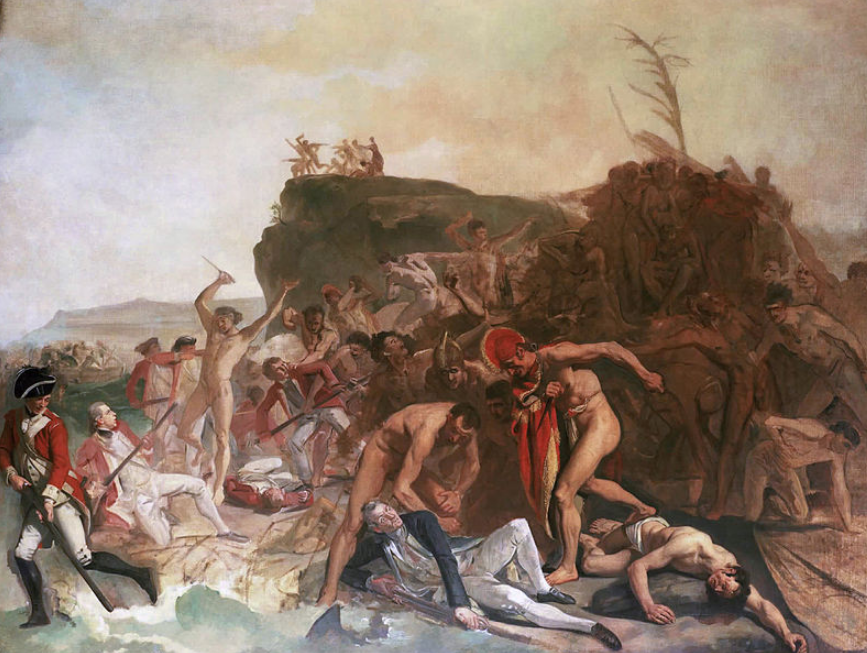 Image: The Death of Captain James Cook, 14 February 1779, an unfinished painting by Johan Zoffany, circa 1795 He was first struck on the head with a club by a chief named Kalaimanokahoʻowaha or Kanaʻina (namesake of Charles Kana'ina) and then stabbed by one of the king's attendants, Nuaa. The Hawaiians carried his body away towards the back of the town, still visible to the ship through their spyglass. Four marines, Corporal James Thomas, Private Theophilus Hinks, Private Thomas Fatchett and Private John Allen, were also killed and two others were wounded in the confrontation.
Read in browser »
   
Feb 10, 2020 04:14 am
 'Devil Dogs' According to Marine Corps tradition, German soldiers facing the Marines at Belleau Wood called them teufelhunden. These were the devil dogs of Bavarian folklore - vicious, ferocious, and tenacious. Shortly thereafter, a Marine recruiting poster depicted a dachshund, wearing an Iron Cross and a spiked helmet, fleeing an English bulldog wearing the eagle, globe and anchor. A tradition was born. Although an “unofficial mascot,” the first bulldog to “serve” in the United States Marine Corps was King Bulwark. Renamed Jiggs, he was enlisted on 14 October 1922 for the “term of life.” Enlistment papers were signed by Brigadier General Smedley D. Butler. Although he began his career as a private, Jiggs was quickly promoted to the rank of sergeant major. His death at the age of four was mourned throughout the Corps. His body lay in a satin-lined casket in a hangar on Marine Corps Base Quantico until he was buried with military honors. (National Museum of the Marines Corps) The following extracts are taken from an article by Brigadier General Dion Williams, USMC, entitled "PRIVATE PAGETT" - US Marine, which appeared in the Marine Corps gazette of September 1927 All over America the press chronicled the death of "Sergeant Major Jiggs" & many friends of the Corps voiced their regret when they heard of his untimely death. One of these friends Mr Allan Cedric Mowbray, an Englishman residing in Boston, Mass, was so impressed with the circumstances of the case that he addressed a letter to the General of the Royal Marines in England Lieut General L.S.T. Halliday V.C., C.B Adjutant General Royal Marines and it was from this letter that the idea to present the USMC with Private Pagett was born.  Private Padgett presented by Lt.General L.S.T. Halliday, Royal Marines. Padgett appears here in a Royal Marines cover. Upon hearing the news that "Sergeant Major Jiggs" had passed away Lieut General L.S.T. Halliday V.C., C.B., Adjutant General Royal Marines decided to give the USMC a British Bulldog by the name of Private Pagett. From Commodore Hartley, Commander of America's greatest passenger ship of its time, the Leviathan, it was learned that "Private Pagett" was escorted aboard the Leviathan by a detachment of Royal Marines from Eastney Barracks Portsmouth & turned over to the care of the Commodore with appropriate ceremonies. During the passage the distinguished passenger fared well & was the centre of interest for the host of passengers that filled the great ship to capacity. On June 27th 1927, the Leviathan arrived at Ney York where, "Private Pagett" was met by the representatives of the US Marine Corps, headed by Major J. C. Fegan, Athletic Officer of the Corps. These representatives consisted of officers of the regular service & the Reserves & a detachment of enlisted men from Brooklyn Barracks. Commodore Hartley turned "Pagett" over to Major Fegan with a few well chosen remarks & he soon boarded a train for the journey to Washington, where on the following day he reported at the Major General Commandant & paid a call upon the Secretary of the Navy. The representative of the press were present & the news of the noted dog's arrival was published throughout the country. Several rolls of moving picture films were made depicting the arrival of "Private Pagett" at New York & Washington, and these together with a collection of clippings from the press recounting the incidents of his reception & induction into the US Marine Corps were forwarded to the Adjutant General of the Royal Marines Lieut General L.S.T. Halliday V.C., C.B. Private Pagett is undoubtedly one of the finest dogs of his class in the world & his fine points are admired by all the dog fanciers & dog lovers who have seen him. He stands nineteen inches high & at present weighs just an even sixty pounds without an ounce of superfluous flesh, in fine form & fettle he is ready for a fight or a frolic & has taken his station at Quantico where he will accompany the Marine Corps Football Team upon its Fall Tour of 1927 & help to cheer them on to victory. Private Pagett also accompanies the Marine Corps Baseball team. No other animal has the traditional courage, bravery, tenacity of purpose, combined with true loyalty, which form the characteristics of the British Bulldog, & this makes "Private Pagett" a fitting mascot for the United States Marines. The Corps esteems him highly for his fine lineage & sterling qualities, but more on account of the fact that he comes to them from another famous Corps of Marines, whose duties are similar, whose language is the same, & whose aspirations & espirit are marked by the same loyalty to flag & country & devotion to the service.The whole Marine Corps will soon become acquainted with "Private Pagett" & will find him a fitting successor to the late lamented "Sergeant Major Jiggs" who won so many friends in & out of service during his 5 years service with the Marines. 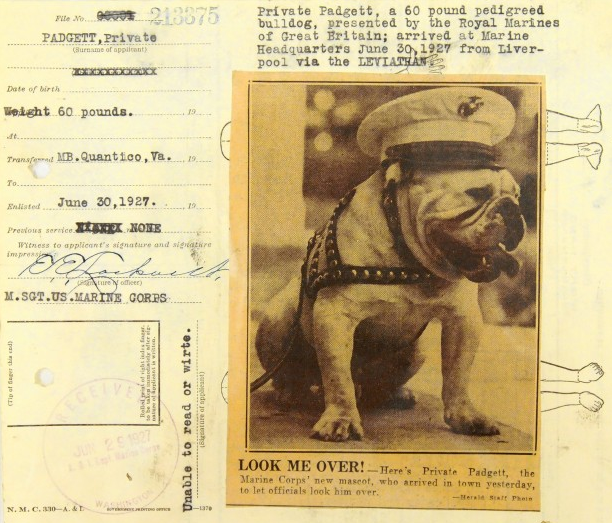 Private Padgett personnel file PRIVATE PADGETT' HAS FUN IN CAPITAL - NY Times June 30, 1927 New Marine Mascot Bowls Over Major Just for Sport and Has His Afternoon Tea. MEETS GEN. LEJEUNE TODAY But He Will Not Meet "Sergeant Major Jiggs II" for Fear of the Consequences. WASHINGTON, June 29. — 'Private Padgett," the pedigreed English bulldog presented to the American marines by the royal marines of Great Britain, which arrived on the Leviathan yesterday, reached Washington this morning in a playful mood and will be officially received with full military honors tomorrow by Major Gen. John A. Lejeune, commandant of the Marine Corps, and the Generals of his staff.
Read in browser »
   
Feb 09, 2020 08:14 am
Thursday, February 9, 1956, Quartermaster Sergeant Alfred Wheeler and Mne. Benet Blakeway, HQ 3 Commando Brigade, died during operations in Cyprus. They both perished from exposure on anti-terrorist operations after their vehicle fell into a deep gully in the Troodos Mountains during a blizzard.  A newspaper report in the Daily Mirror on the 11th February 1956 states: "RSM gave life for Commando. One of the two British Commandos who died in a mountain blizzard in Cyprus was a regimental sergeant major. And he gave his life, it was revealed yesterday, in a vain bid to save the other Commando - a Marine who had hurt his ankle and could not go on without help. The hero was R.S.M. A. Wheeler. whose wife lives in Springfield Terrace, Elburton, Plymouth. The Marine he gave his life for was Benet Carr Blakeway, 25, son of the Rev. B. C. Blakeway, Vicar of Crayrigg, near Kendal, Westmorland. R.S.M. Wheeler dropped out of a party of Commandos to go to Marine Blakeway's assistance . The rest of the party arrived safely at base." WHEELER, Alfred Quartermaster Sergeant Unit/Base: '3 Commando Brigade RM' Regiment/Corps: Royal Marines Service number: PO/X 5243 Born: Wednesday, September 3, 1924 Died : Thursday, February 9, 1956 Died on active service Age: 31 Cemetery/Memorial: Waynes Keep Military Cemetery Nicosia Cyprus BLAKEWAY, Benet Carr Rank: Marine Unit/Base: '3 Commando Brigade RM' Regiment/Corps: Royal Marines Service number: CH/X 5377 Born: Monday, February 10, 1930 Died : Thursday, February 9, 1956 Died on active service Age: 25 Cemetery/Memorial: Waynes Keep Military Cemetery Nicosia Cyprus
Read in browser »
   
Feb 09, 2020 07:44 am
Operation Diesel Unit/ Formation: RM ASG Location: Helmand Period/ Conflict: War in Afghanistan (2001-)  Date/s: 9th February 2009 Operation Diesel was a raid by 700 British troops from the Royal Marines 45 Commando, 42 Commando, and the 3 Commando Brigade's Reconnaissance Force, as well as armoured infantry and close reconnaissance from 1st Battalion Princess of Wales's Royal Regiment (1 PWRR) on a Taliban drug factory and arms stronghold in the Upper Sangin Valley in Helmand province, Afghanistan on February 7, 2009. British forces involved in the operations included: Special Boat Service (SBS)42 Commando Royal Marines45 Commando Royal Marines3 Commando Brigade's Brigade Reconnaissance Forcearmoured infantry and close reconnaissance from 1st Battalion The Princess of Wales's Royal Regiment (1 PWRR).Army WAH-64 Apache, RAF Chinook, RN Sea King HC4 and Lynx AH7 helicopters of the Commando Helicopter Force OP Diesel was comprised of several key actions: Proceeding the main operation, British forces, including 1 PWRR and Viking APCs from the Armoured Support Group, carried out a number of deception operations in and around Op Diesel's multiple targets in order to distract the Taliban and draw them away from the area.On the night of Feb 6th, under the cover of darkness, a number of Brigade Reconnaissance Force MWMIK Jackals moved into position on high ground looking over the targets, a series of compounds and farms situated in the Helmand valley. From their high vantage point, the BRF was in a position to provided covering fire for 2 helicopter landing zones in the valley below.8 km west of the objectives, APCs from 1PWRR secured a further helicopter landing zone and also position themselves as a blocking force against Taliban counter attackVikings from the Armoured Support Group set up a screen to the south. Covered by the ground elements, up to 500 Royal Marines Commandos were inserted into the 3 landing zones by waves of helicopters. view graphic of helicopter insertions during Operation Diesel Elements from 45 and 42 Commando then moved out from their insertion points to search and secure the various compounds and farm buildings, whilst other elements moved into position to provided cover for their fellow Commandos.The precise role of the SBS during Op Diesel has not been disclosed to the public.  In the early hours of February 7 the raid was launched. Within 20 minutes two waves of RAF Chinooks, Royal Navy Sea Kings, Lynx and American Sea Stallions delivered 500 troops from 45 Commando Royal Marines and both British and Afghan special forces into three landing zones half-a-mile from enemy positions. Large vats of opium were abandoned while still being boiled as the Taliban fled the assault. 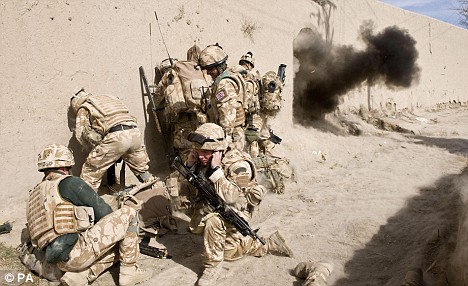 The Task Force Helmand commander, Brig Gordon Messenger called Operation Diesel a "clinical precision strike" that had "a powerful disruptive effect on known insurgent and narcotics networks in the area". Four drugs factories were captured along with gallons of chemicals used to process opium into heroin. Large numbers of machine guns were also recovered as well as a motor bike that had been primed as a suicide bomb. Twenty Taliban fighters defending the drugs were killed. No UK personnel were killed in the assault. 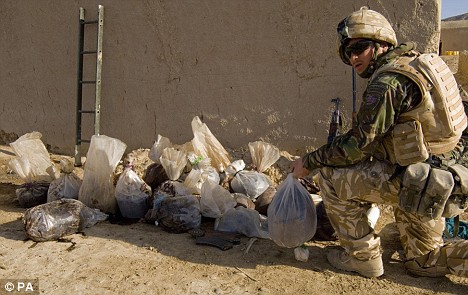 The raid captured four drug factories and heroin and opium worth £50 million.
Read in browser »
   
Feb 05, 2020 08:05 am
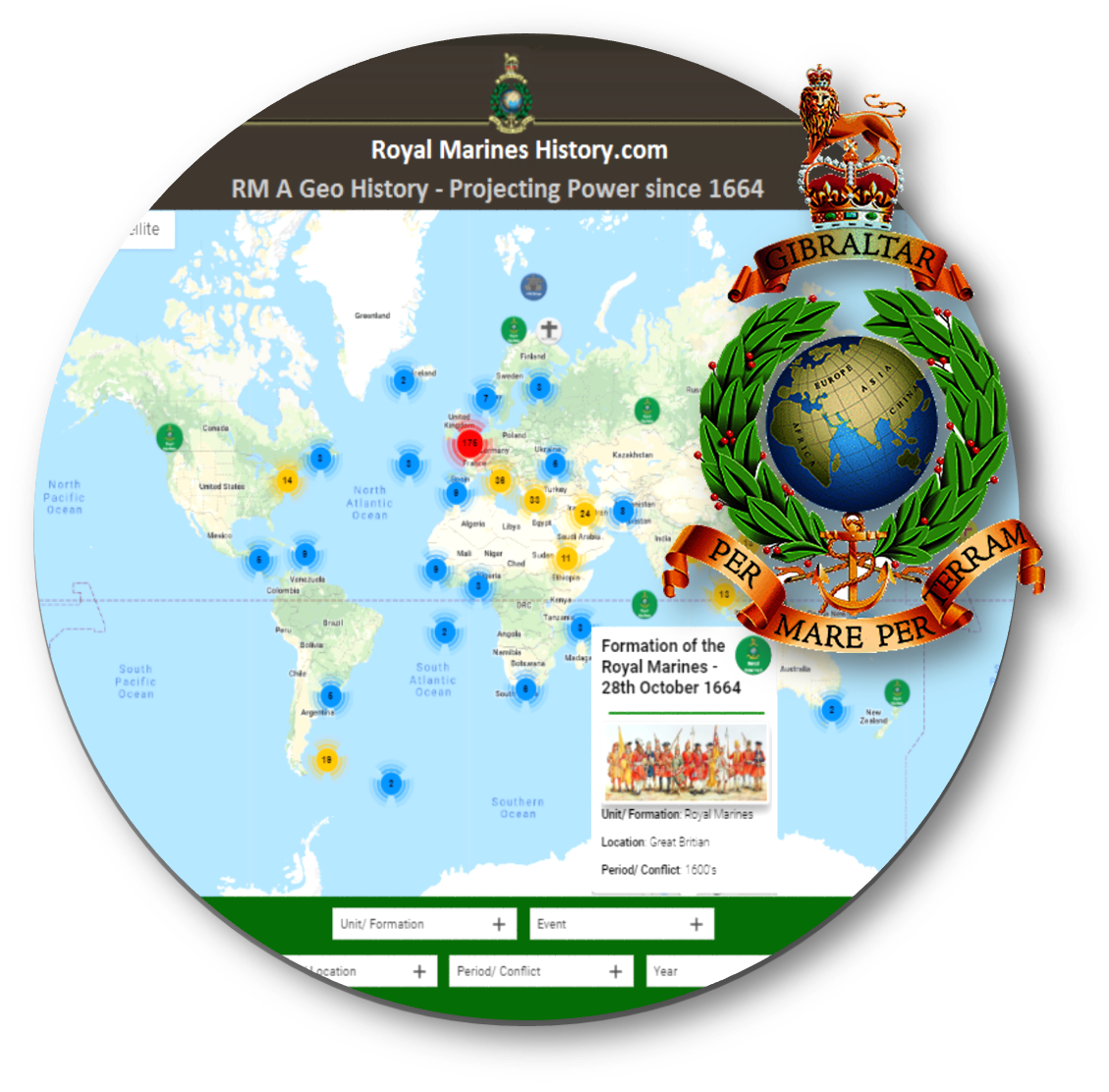 The "Great Globe itself" was chosen in 1827 by King George IV in place of Battle honours to recognise the Marines' service and successes in multiple engagements in every quarter of the world. Although Marines have certainly circumnavigated the globe and traveled to almost every country how extensive has that reach been? Using the RM Geo History Map as a reference and only counting 'Actions' and assuming that Marines have seen action in the Fleet across the Atlantic and Pacific Oceans, thus far of the 543 pins marked the furthest apart that Marines have been in action is between Hawaii and New Zealand, a mere 4,606 miles! They have also been in action at the most extreme of Cardinal Points; 62°57‘N (Arctic Convoys 1941 - 45)176°09‘E (Battle of Gate Pā Pukehinahina 1863)62°57‘S (Raid on Deception Island 1953)155°56W (Marines Killed alongside Cook 1779)  Please also consider supporting the new Royal Marines Museum as they raise money to open a new museum telling the story of the Royal Marines.
Read in browser »
   
Feb 04, 2020 08:42 am
The French brig sloop ‘Curieux’ was fitted out at Martinique in order to attack British interests, as she was a threat to British West Indian commerce, the British Commodore Hood gave orders for her capture.  Under the command of Lieutenant Robert Carthew Reynolds four boats with 60 seamen and 12 marines set out on a moonlit night from the British ship ‘Centaur’. This meant a 20-mile row to reach the ‘Curieux’ lying under the protection of the guns of Fort Edward.  When Reynolds’s barge came in under the stern of the ‘Curieux’ he found that, providentially, a rope ladder hung down the side. He scaled it and cut a hole in the anti-boarding nets to enable his men to pour on board. Before she was taken the French lost nearly 40 killed and wounded. The British had nine wounded including Reynolds. The British sent Curieux under a flag of truce to Fort Royal to hand the wounded over to their countrymen. The Royal Navy took her into service as HMS Curieux, a brig-sloop. Reynolds commissioned her but he had been severely wounded in the action and though he lingered for a while, died in September Painting: The cutting out of the Curieux, Martinique, 4th February 1804, Mark Richard Myers, P.R.S.M.A. (San Mateo, California b.1945)
Read in browser »
   
Feb 04, 2020 08:35 am
Unit/ Formation: Royal Marines Location: Singkep Islands Period/ Conflict: World War II Year: 1942 Date/s: February During the general evacuation of Singapore a party including Argyll Marines left in a motor-launch commanded by a lieutenant, R.N.V.R. 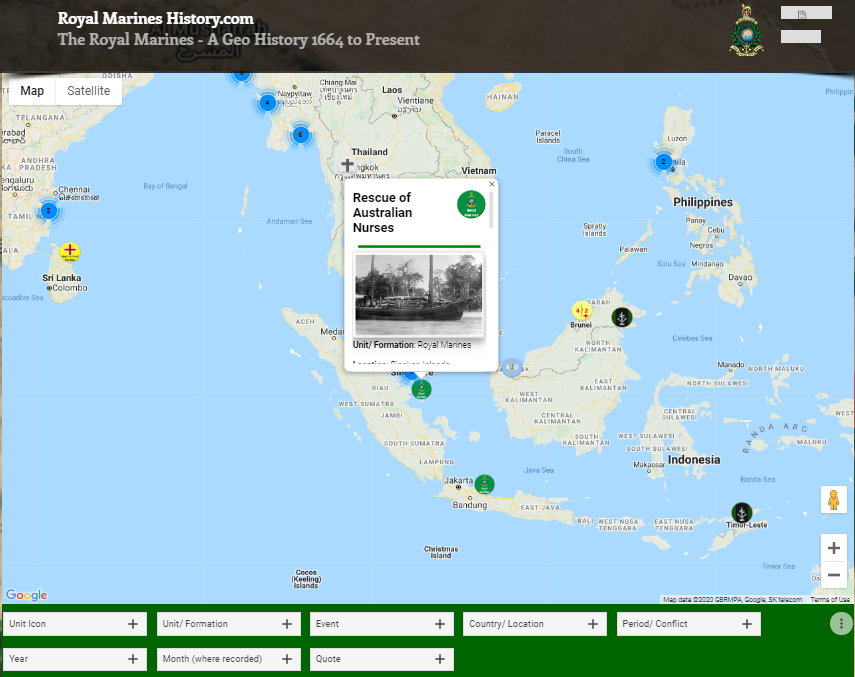 They reached the Dutch island of Singkep, where they found 800 soldiers and seamen. Nearby was another island where there was a number of Australian nurses and white women refugees. The Japanese were systematically bombing it and sending boats to capture the women. Some of the marines at Singkep joined a party of volunteers in a motor-launch towing flat-bottomed boats, brought off the women who were alive, and buried the dead. They finally left Singkep in a motor-boat with 300 on board including two new born babies, towing another, which sank.  A flat bottomed Tongkang; similar to one provided by 'Dutchy' for tge survivors to escape Organised by the local Dutch Administrator in the small settlement of Dabo on Singkep, known as 'Dutchy', who then set up an escape pipeline for all those that passed through his island. The survivors. were taken aboard the first boat, and all reached Padang, in Sumatra, whence they, too, were sent to Colombo. Information extracted from Judy: A Dog in a Million by Damien Lewis ( Amazon)
Read in browser »
   
Feb 02, 2020 09:37 am
After the Anzio landings the Commandos of 2 SS Brigade were placed in reserve before returning to Naples on an LST (Landing Ship Tank), arriving there on the morning of the 25th January and placed on a state of readiness for further action at short notice. 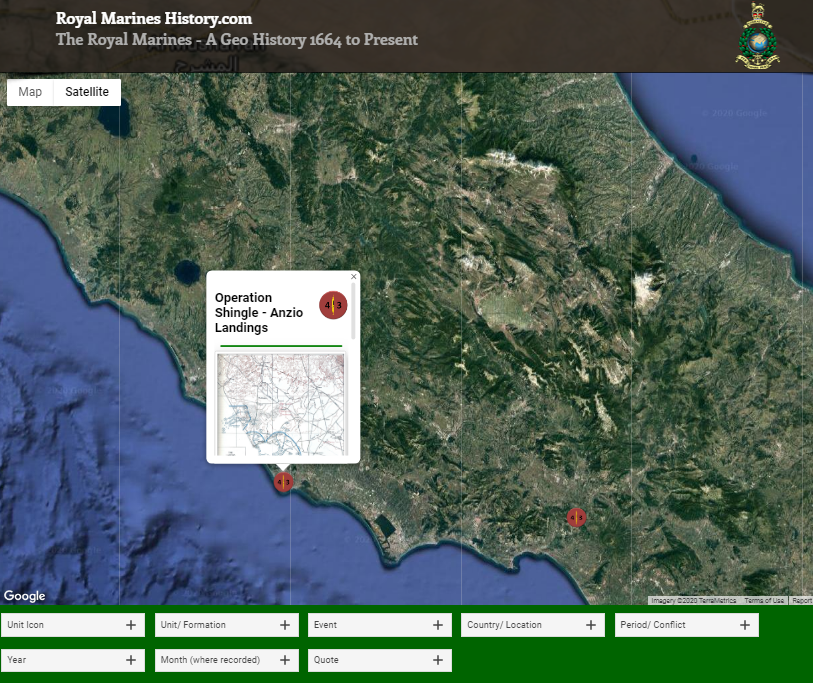 Initially No 9 and No 43(RM) Commandos were to join No 40 (RM) Commando to form part of a counter-attack force. However, General McCreery, the Commander of X Force, decided that Nos 9 and 43(RM) Commando would extend his foothold in the hills west of Garigliano by taking control of the three peaks of Monte Ornito - Tugo (2000 ft), Ornito (2,400 ft) and Faito (3000 ft). The terrain was rocky, uneven and in places very steep with scree slopes and there was virtually no cover. Even without enemy action, supplying troops on these summits with food, water and ammunition would involve a great deal of human effort. On 26th January 1944, the Commandos re-joined the 56 London Division. To the north, the 46th and 56th Infantry Divisions were holding onto positions opposite the heavily defended Gustav Line. The winter cold and exhaustion had compromised the fighting strength. 2 Feb 1944 The 2 Commandos 40 Cdo and 9 Cdo plus the Belgium Troop would advance in column led by 43 Cdo who were to seize Ornito and a subsidiary feature point 711, making an approach march of about 2 miles from the start line.  9 Commando would by pass Ornito and Take Faito a distance of about 3 miles The leading troop of 43 Cdo led off at 18:30 under bright moonlight and made steady progress, even though the going was touch and arduous, they encountered machine gun and mortar fire from enemy outposts; but nether-the-less secured both Mount Ornito and 711 by first light. Though not with out casualties. The Marines captured over 30 prisoners. No 9 Commando passed Monte Tugo and proceeded NW, where they came under heavy fire from a feature in front of Monte Faito. Three Troops overran the stronghold against heavy mortar and shell fire, causing some casualties and firing continued while the Commando consolidated and reorganised. Their advance continued still under fire, during which Tod suffered a bad injury to an arm. Major E W Clark, the 2nd in command, was killed and six other officers wounded. Against the withering fire they withdraw to Monte Ornito. 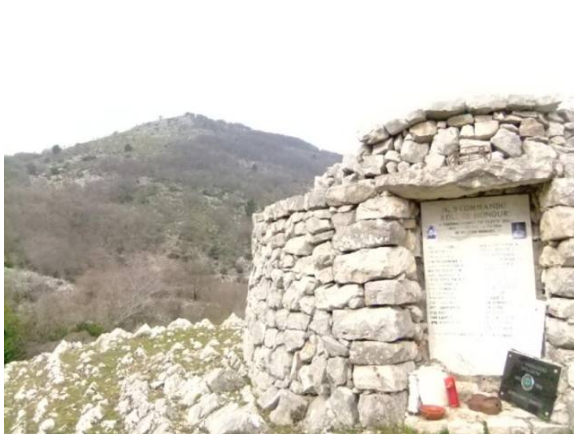 Commando Monument at Mount Ornito, Italy Photo courtesy of Salvatore Costanzo.se. (Commando Veterans Archive) Interrogation of prisoners indicated that the enemy had withdrawn to Monte Faito and a counter attack was likely. Tod was ordered to hand over command to his 2nd in command. Against such determined opposition, reinforcements were needed to continue the attack but meantime the increasing intensity of the enemy artillery indicated that a counter attack was imminent. At 1600 hours it started with No 43 (RM) Commando taking the brunt, but they succeeded in beating it off. After heavy fighting for a day and a half, Mont Ornito and Point 711 had been captured despite the Commando HQ being mortared with some casualties. Monte Faito failed to be captured. These actions were in the most appalling winter conditions where all munitions, food and water had to be carried on the soldiers backs since the terrain was too steep for mules and the Germans were in well-fortified positions. Such was the German determination to hold on to their defensive position, it changed hands 6 times in the ensuing months before finally falling to French Expeditionary Corps in the spring of 1944. Captain John Blake awarded the Military Cross Temporary Lieutenant (A/Captain) John Philip BLAKE, Royal Marines. For outstanding gallantry and leadership shown while serving with the 43rd Royal Marine Commando in the attack which led to the capture of Mt Ortino, Italy on 3rd February 1944. On reaching the top of the Mount, through heavy machine gun fire, without hesitation and heedless of the danger from grenades, he led the forward section of his Troop in a bayonet charge on the enemy position and captured 20 prisoners. Later in the day during a strong enemy counter attack, this gallant officer moved from position to position encouraging his men and directing their fire  Temporary Lieutenant (A/Captain) John Philip BLAKE, Royal Marines. Credit: Sherborne School Archives, Abbey Road, Sherborne, Dorset, UK, DT9 3AP.
Read in browser »
   
|